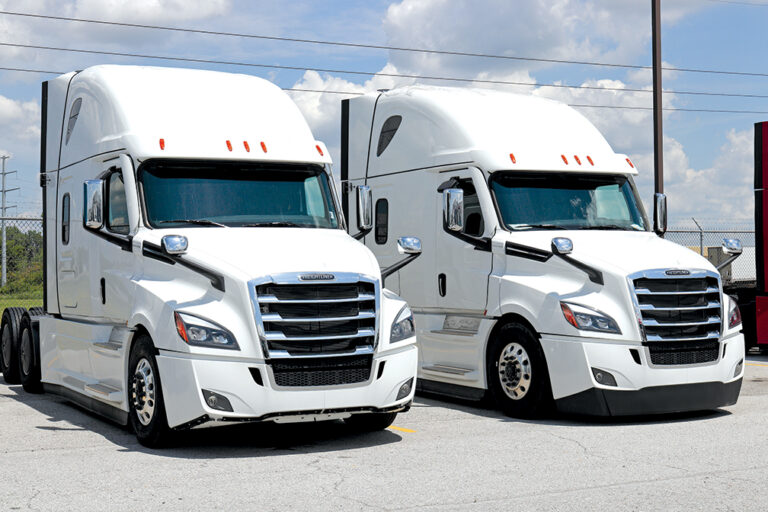Plagued by supply chain constraints throughout 2021, manufacturers of Class 8 trucks stepped up both production and sales in December, achieving the third-best December monthly sales to date. Only the final months of 2006 and 2018 saw more trucks sold on the U.S. market.
According to data provided by ACT Research, manufacturers reported U.S. sales of 25,116 new Class 8 trucks in December, an increase of 47.6% over November sales of 17,021. While December is almost always the best sales month of the year, the final numbers were unexpected.
After starting December with minimal inventory, North American production numbers accounted for the increase
“The bigger story is that for the three month period of September through November, Class 8 build averaged perfectly at 1,000 units per day,” explained Kenny Vieth, president and senior analyst at ACT. “In December, the build was 1,549 units per day.”
With shortages of semiconductors, plastics and other materials and components, OEM production numbers have been reduced all year. So, where did the parts come from in December? In a year that saw long wait times for ordered trucks and the implementation of price increases and surcharges, OEMs pulled out the stops to deliver as many trucks as possible.
One possibility for the increased production is the backlog of “red-tagged” trucks at manufacturers. These are trucks that have been built but lack a critical component or two, so they’re stored until the parts arrive. Once parts are available, the trucks can be quickly finished and sold.
Another is that components were pulled from another business segment. For example, semiconductors that normally go into aftermarket parts could be diverted to assembly of new trucks, with the assumption that builders can reverse the process in January, which is typically a slow sales month. However it happened, OEMs are unlikely to go public with any trade secrets.
“The sustainability is another question,” Vieth said. “There’s the push to get those trucks off the books for 2021 and get them into the hands of dealers and customers. Customers wanted them in the fleet by year-end for the tax advantages.”
In summary, a great December doesn’t mean supply chain problems have been solved and production will continue at a high pace. The wait is still a long one for new trucks, and units ordered today will take a year or more to be built and delivered.
While orders for new trucks are still strong, ACT reported preliminary December orders of 22,800 trucks, a smaller number than seen in prior months. It’s not that customers don’t want more trucks. It’s that the build slots for 2022 are already filled and OEMs don’t want to accept more orders than they can produce before the next model year comes out.
“Modest December net orders reflect OEMs taking a more cautious approach to effectively manage the cycle of customer expectations,” Vieth stated in a Jan. 5 news release.
As long as business remains good, the trucking industry will keep ordering tractors.
“The underlying demand metrics are still strong,” Vieth explained. “Freight rates are good, profits are good, the economy’s growing nicely. So, demand is in good shape. Truckers are gonna make a lot of money in 2022, and the manufacturers will build as many vehicles as supply chain constraints allow them to build.”
The used truck market has also been impacted by the slowed production of new trucks. Although sales of used Class 8 trucks grew 4% over November numbers, they were 30% lower than December 2020. The reason is supply. Inventories have been depleted as buyers turn to the used truck market to find equipment. And, with fewer new trucks being built, fewer trade-in units make it to the used truck market.
Average prices, which rise when the demand is high and supply is low, have increased by 42%, according to a Jan. 14 release from ACT. The average used truck age has increased slightly, and there are a few more miles on the odometer — a symptom of carriers holding on to trade trucks until replacements are delivered.
All OEMs that provided reports improved in December, according to data received from Wards Intelligence; all numbers represent sales on the U.S. market.
Freightliner topped the list with sales of 8,315, increasing 35.6% over November sales of 6,234.
International sales increased 62.2% in December with 2,131 trucks sold compared to 1,314 in November.
Volvo sales increased 78.6% from November sales of 2,048 to December’s 3,657 sold. Volvo-owned Mack more than doubled November sales of 1,356, selling 2,926 in December for a 115.8% increase.
Kenworth sold 3,680 trucks in December, besting November’s 2,342 by 57.1%. PACCAR sibling Peterbilt sold 3,405 vs. 2,842 in November for a 19.8% increase.
Western Star’s 609 trucks sold in December was 19.7% ahead of November’s 503 sold.
For the year, Freightliner sold 8,315 trucks on the U.S. market, good for 33.6% of trucks sold by the major manufacturers. Peterbilt was next with sales of 32,810 and 14.8% of the market, while Kenworth followed with 32,301 sold and a 14.6% share. Together, the PACCAR companies represented 29.3% of the new Class 8 market in the U.S. for the year.
Volvo captured 10.0% of the 2021 market with sales of 22,104, while Mack took 8.4% with sales of 18,668. Together, the Volvo-owned companies were responsible for 18.4% of Class 8 trucks sold.
International’s year ended with 11.9% of the new, Class 8 market with sales of 26,387. Finally, Western Star’s 6,022 trucks sold took 2.7% of the market.
As 2022 unfolds, it’s anyone’s guess how the trucking industry will be impacted by the Omicron variant of COVID-19. In the meantime, volatile fuel prices, the threat of severe winter weather and the possibility of war in the Ukraine are known variables that could negatively impact the supply chain.
Still, conditions remain favorable for trucking through the coming months and possibly beyond.
Cliff Abbott is an experienced commercial vehicle driver and owner-operator who still holds a CDL in his home state of Alabama. In nearly 40 years in trucking, he’s been an instructor and trainer and has managed safety and recruiting operations for several carriers. Having never lost his love of the road, Cliff has written a book and hundreds of songs and has been writing for The Trucker for more than a decade.














